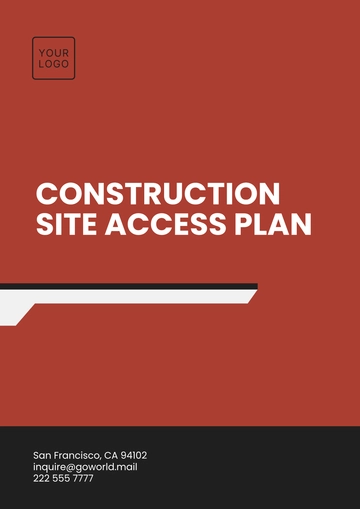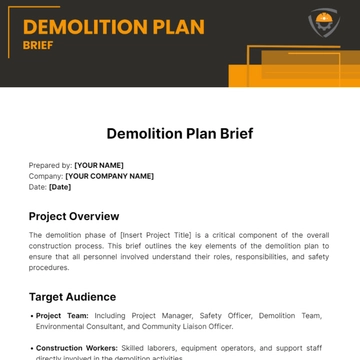Free Demolition Site Safety Plan Design

Project Name | Downtown Mall Demolition |
Location | 123 Main Street, Anytown, USA |
Project Start | January 15, 2055 |
Project Completion | March 30, 2055 |
Prepared by | [Your Name] |
Company Name | [Your Company Name] |
I. Introduction
Demolition work is inherently dangerous and requires comprehensive safety measures to safeguard workers, the public, and surrounding properties. This plan outlines the required safety protocols to ensure a safe demolition site. Our primary objectives are to minimize the risk of accidents, ensure compliance with legal requirements, and protect all stakeholders involved in the demolition process.
II. Preliminary Preparations
A. Site Assessment
A thorough assessment of the site will be conducted to identify potential hazards, including:
Nearby Structures: Evaluate the proximity of adjacent buildings and structures to assess risks of collapse or debris.
Utilities: Identify overhead and underground utilities, such as power lines, gas, and water lines. Coordinate with utility companies to disconnect services as needed.
Environmental Concerns: Assess the site for hazardous materials, such as asbestos or lead paint, and determine the appropriate remediation procedures.
B. Permits and Approvals
Before commencing demolition activities, the following permits and approvals will be obtained:
Demolition Permit: Required from local authorities to proceed with demolition.
Environmental Permits: Necessary if hazardous materials are present or if there are specific environmental regulations.
Utility Clearance: Confirmation from utility companies regarding the safe disconnection of services.
III. Safety Measures
A. Personal Protective Equipment (PPE)
All workers must be equipped with the following PPE:
Hard Hats: To protect against head injuries from falling debris.
Steel-Toe Boots: To prevent foot injuries from heavy objects.
High-Visibility Vests: To ensure workers are easily seen by machinery operators and others on site.
Gloves: To protect hands from cuts and abrasions.
Safety Goggles: To safeguard eyes from dust and flying debris.
Respiratory Protection: Required if working in areas where dust or hazardous materials are present.
Responsibility for PPE: The demolition contractor will provide all required PPE, and workers will receive training on its proper use and maintenance.
B. Site Layout and Signage
Site Boundaries: Mark the site boundaries with fencing or barriers to prevent unauthorized access.
Warning Signs: Install appropriate signage around the perimeter of the site to alert the public and unauthorized personnel of demolition activities, including signs indicating "No Entry" and "Hard Hat Area."
IV. Hazard Control
A. Dust and Debris Control
To minimize dust and manage debris, the following measures will be implemented:
Water Suppression: Utilize water hoses or misting systems to reduce dust emissions during demolition.
Debris Netting: Install netting around the demolition area to contain debris and prevent it from spreading to surrounding areas.
Enclosed Chutes: Use enclosed chutes for debris removal to minimize dust and control debris fall.
B. Noise Control
To comply with local noise regulations and minimize the impact on nearby communities:
Noise Barriers: Erect temporary noise barriers around the site to absorb and deflect sound.
Equipment Selection: Use quieter equipment and machinery where possible, and schedule noisy activities during off-peak hours.
V. Emergency Procedures
A. Emergency Contacts
Maintain an up-to-date list of emergency contacts, including:
Service | Contact Number |
|---|---|
Fire Department | 123-456-7890 |
Police Department | 123-456-7891 |
Medical Services | 123-456-7892 |
Site Safety Officer | [Yor Name], [Your Company Number] |
B. Evacuation Plan
An evacuation plan will be developed and communicated to all workers. The plan includes:
Evacuation Routes: Marked routes to safe assembly points outside the danger zone.
Regular Drills: Conduct monthly evacuation drills to ensure all personnel are familiar with procedures and routes.
VI. Compliance and Training
A. Regulatory Compliance
Ensure that all activities comply with:
OSHA Regulations: Adherence to all Occupational Safety and Health Administration (OSHA) standards relevant to demolition work.
Local Safety Standards: Compliance with any additional local regulations or requirements specific to the demolition site.
B. Worker Training
Provide regular training sessions for all workers covering:
Site Safety Protocols: Training on specific safety measures and equipment.
Hazard Recognition: Education on identifying potential hazards on the site.
Emergency Procedures: Familiarization with emergency contacts and evacuation plans.
Training sessions will be conducted before demolition begins and refreshed every three months.
VII. Conclusion
Implementing a comprehensive Demolition Site Safety Plan is crucial to protecting workers and the public. By adhering to established safety guidelines and regulations, we can ensure a safe and efficient demolition process. Continuous monitoring and improvement of safety practices will be prioritized throughout the project to address any new hazards that may arise.
- 100% Customizable, free editor
- Access 1 Million+ Templates, photo’s & graphics
- Download or share as a template
- Click and replace photos, graphics, text, backgrounds
- Resize, crop, AI write & more
- Access advanced editor
Ensure a safe demolition process with the Demolition Site Safety Plan Design Template from Template.net. This editable and customizable template is specifically designed to meet the unique demands of demolition projects. Easily modify its content to align with your site’s specific safety requirements and regulations. With a clear format and detailed guidelines, you can effectively communicate safety measures to your team, fostering a secure work environment. Optimize your safety planning today!
You may also like
- Finance Plan
- Construction Plan
- Sales Plan
- Development Plan
- Career Plan
- Budget Plan
- HR Plan
- Education Plan
- Transition Plan
- Work Plan
- Training Plan
- Communication Plan
- Operation Plan
- Health And Safety Plan
- Strategy Plan
- Professional Development Plan
- Advertising Plan
- Risk Management Plan
- Restaurant Plan
- School Plan
- Nursing Home Patient Care Plan
- Nursing Care Plan
- Plan Event
- Startup Plan
- Social Media Plan
- Staffing Plan
- Annual Plan
- Content Plan
- Payment Plan
- Implementation Plan
- Hotel Plan
- Workout Plan
- Accounting Plan
- Campaign Plan
- Essay Plan
- 30 60 90 Day Plan
- Research Plan
- Recruitment Plan
- 90 Day Plan
- Quarterly Plan
- Emergency Plan
- 5 Year Plan
- Gym Plan
- Personal Plan
- IT and Software Plan
- Treatment Plan
- Real Estate Plan
- Law Firm Plan
- Healthcare Plan
- Improvement Plan
- Media Plan
- 5 Year Business Plan
- Learning Plan
- Marketing Campaign Plan
- Travel Agency Plan
- Cleaning Services Plan
- Interior Design Plan
- Performance Plan
- PR Plan
- Birth Plan
- Life Plan
- SEO Plan
- Disaster Recovery Plan
- Continuity Plan
- Launch Plan
- Legal Plan
- Behavior Plan
- Performance Improvement Plan
- Salon Plan
- Security Plan
- Security Management Plan
- Employee Development Plan
- Quality Plan
- Service Improvement Plan
- Growth Plan
- Incident Response Plan
- Basketball Plan
- Emergency Action Plan
- Product Launch Plan
- Spa Plan
- Employee Training Plan
- Data Analysis Plan
- Employee Action Plan
- Territory Plan
- Audit Plan
- Classroom Plan
- Activity Plan
- Parenting Plan
- Care Plan
- Project Execution Plan
- Exercise Plan
- Internship Plan
- Software Development Plan
- Continuous Improvement Plan
- Leave Plan
- 90 Day Sales Plan
- Advertising Agency Plan
- Employee Transition Plan
- Smart Action Plan
- Workplace Safety Plan
- Behavior Change Plan
- Contingency Plan
- Continuity of Operations Plan
- Health Plan
- Quality Control Plan
- Self Plan
- Sports Development Plan
- Change Management Plan
- Ecommerce Plan
- Personal Financial Plan
- Process Improvement Plan
- 30-60-90 Day Sales Plan
- Crisis Management Plan
- Engagement Plan
- Execution Plan
- Pandemic Plan
- Quality Assurance Plan
- Service Continuity Plan
- Agile Project Plan
- Fundraising Plan
- Job Transition Plan
- Asset Maintenance Plan
- Maintenance Plan
- Software Test Plan
- Staff Training and Development Plan
- 3 Year Plan
- Brand Activation Plan
- Release Plan
- Resource Plan
- Risk Mitigation Plan
- Teacher Plan
- 30 60 90 Day Plan for New Manager
- Food Safety Plan
- Food Truck Plan
- Hiring Plan
- Quality Management Plan
- Wellness Plan
- Behavior Intervention Plan
- Bonus Plan
- Investment Plan
- Maternity Leave Plan
- Pandemic Response Plan
- Succession Planning
- Coaching Plan
- Configuration Management Plan
- Remote Work Plan
- Self Care Plan
- Teaching Plan
- 100-Day Plan
- HACCP Plan
- Student Plan
- Sustainability Plan
- 30 60 90 Day Plan for Interview
- Access Plan
- Site Specific Safety Plan






















